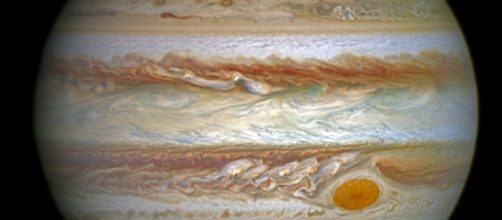NASA's Juno probe in Jupiter's orbit celebrates its anniversary on the planet's region this month. On July 10, the spacecraft will fly over the planet's most prominent feature, the Great Red Spot.
The Great Red Sport is a 10,000-mile-wide (16,000 kilometer) storm visible on the surface of Jupiter. Jupiter earned the name biggest and "baddest" planet in the Solar System due to its harsh conditions. Juno was designed to survive the weather on Jupiter and is expected to provide the first close-up image of the Great Red Spot during its upcoming flyby.
Jupiter's storm
The spot has been the target of studies since 1830. But due to the difficulty in sending spacecraft to the region, and in developing a man-made object that can withstand the conditions in the region, it is only today that mankind will attempt to fly close to the mark on the surface of the giant Gas Planet.
Scott Bolton, the principal investigator for NASA's Juno Probe said that the Great Red Spot is the best-known feature of the planet. The storm has been visible for centuries. This will be the first time, Juno with its scientific equipment onboard will attempt to closely observe and understand how the gigantic storm works and what makes it more special.
Flyby
Currently, Juno is collecting scientific data about Jupiter during its flybys to the planet.
So far, it managed to observe the cloud tops on the northern hemisphere of the planet. The next flyby will occur on July 10 when the Perijove is happening. Perijove is the point where the spacecraft orbit comes closest to Jupiter paving the way for a close pass.
Juno will attempt to cross the Great Red Spot and approach it close at 6:55 pm (EDT) on July 10.
By this time, Juno will be 2,200 miles (3,500 kilometers) above the planet's cloud tops. In about 11 minutes and 33 seconds, the spacecraft will cover 24,713 miles (39, 771 kilometers) of the planet's surface, according to NASA. During this time, Juno will fly directly above the red storm spot at about 5,600 miles (9,000 kilometers).
There will be eight scientific instruments on board functioning during the flyby including the most crucial, the JunoCam. The imager is expected to capture the most detailed and closest image of the Great Red Spot.
Last July 4, Juno celebrated its one year anniversary in Jupiter's orbit. Today, it has completed 71 million miles (114.5 million kilometers) orbiting the giant gas planet.
According to the team, each orbit will give scientists new data that will help them further understand the origin and composition of the giant gas planet. Understanding Jupiter and its origin are vital because it can lead to a better understanding of the planet Earth and the universe in general.
So far, Juno has proven to be a reliable spacecraft that was able to withstand the electron storms around the region.
Scientists and engineers are hoping the Juno will be able to continue further in order to collect more data.
July 10, @NASAJuno spacecraft will fly directly over Jupiter’s Great Red Spot, giving humanity its 1st up-close view https://t.co/2Q1iVr4dNE pic.twitter.com/O4nkOQE5UA
— NASA (@NASA) July 1, 2017


